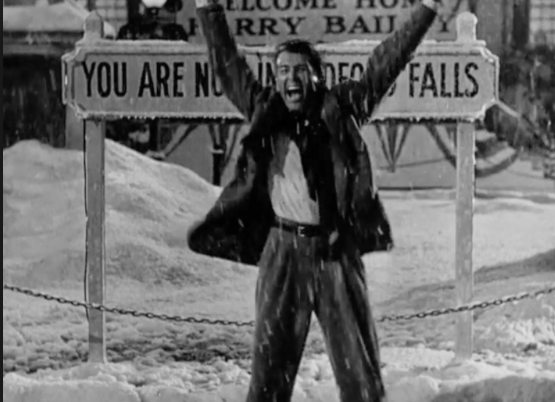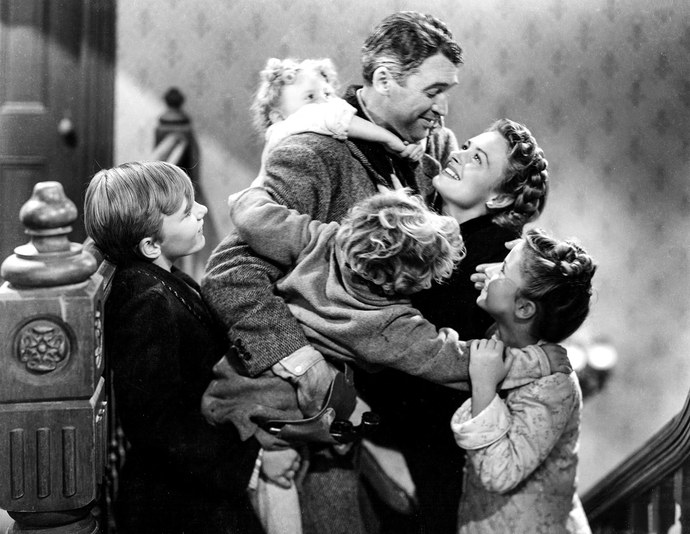It’s a Wonderful Life (1947)
CAST: James Stewart, Donna Reed, Lionel Barrymore, Thomas Mitchell, Henry Travers, Ward Bond, Frank Faylen, Gloria Grahame
REVIEW:
Contrary to popular belief, It’s a Wonderful Life took a while to achieve its beloved status and was not an immediate hit. In fact, it received mixed critical reviews and despite being nominated for five Academy Awards, including Best Picture and Best Actor, it won none of them and barely made back its budget costs at the box office. But after its copyright was allowed to expire in 1974 and the film entered the public domain, the previously relatively forgotten movie became a mainstay re-running on television during the Christmas season and enraptured new generations of viewers, in both the original black-and-white version and subsequent colorizations, until 1994 when NBC obtained exclusive rights to its television broadcasts. Today, It’s a Wonderful Life is held up as such a timelessly popular Christmas movie (though only the climax actually takes place at Christmastime) that it’s strange to think it was once received lukewarmly. There’s reasons why It’s a Wonderful Life holds a timeless appeal. It’s a “feel good” movie through and through, but a well-constructed “feel good” movie that isn’t so saccharine as to avoid some darker moments (the central premise, after all, involves a man believing the world would be better off if he’d never existed and contemplating suicide) and holds some themes about the importance of the individual and the triumph of human values over penny-pinching bottom lines that feel just as timely and relevant today.
The movie chronicles the life of George Bailey (Bobbie Anderson as a boy, later James “Jimmy” Stewart) from his boyhood in 1919 until the pivotal moment upon which everything hinges in 1946. Growing up in the sleepy little town of Bedford Falls, where his father’s Bailey Building & Loan Society is the only institution in town that stands as a bulwark against the complete domination of big bad businessman Mr. Potter (Lionel Barrymore), George has bigger dreams, longing to shake off the dust of Bedford Falls and see the world as an adventurous explorer. But a series of events, starting with the sudden death of his father, always crop up to keep George’s feet in his hometown and stepping into his Dad’s shoes, first unwillingly, then becoming an impassioned defender of the little guy. Along the way, he courts and ultimately marries and has a brood of children with Mary (Donna Reed). But eventually, a financial crisis drives George into an abyss of despair and one cold, snowy Christmas night, he finds himself standing on a bridge overlooking the river and contemplating suicide. But George’s life has had a lifelong observer: the fledgling angel Clarence (Henry Travers), who hopes to earn his wings by fulfilling his mission to save George’s life. To this end, he seeks to teach George his value by showing him a world where he’d never been born.
The nightmarish alternate timeline Clarence escorts George through is probably the best-known sequence of the movie—though it comprises a fairly small portion of the runtime late in the film—and bears a passing resemblance to A Christmas Carol (supernatural entities escort the protagonist through dark alternate events to change their perspectives), but It’s a Wonderful Life works on many levels, smoothly integrating moments of romance (George’s courting of Mary), humor (an impromptu swim at a high school graduation dance), and pathos (the death of George’s father, among other moments). Sure, it’s “feel good” emotional manipulation, but it’s done skillfully enough to produce some wet eyes (there’s even a poignant moment before Jimmy Stewart even shows up, where young George saves his grief-stricken pharmacist boss from making a terrible mistake), and while the tone is predominantly upbeat and life-affirming, it doesn’t play so safe as to be devoid of more serious elements. The underlying theme of the importance of the individual as a human being, rather than the bottom line, is given voice in an impassioned tirade by George that feels just as timely and relevant today as it did in 1947 (maybe even more so), and the movie doesn’t shy away from George showing a darker side in the climax as his woes bring him to a breaking point. On a technical level, It’s a Wonderful Life was an impressive production. A 300-yard “main street” was constructed for the film with over eighty stores and buildings and twenty transplanted oak trees, with loads of artificial snow (including 3,000 tons of shaved ice) used for Christmastime scenes filmed in the scorching July heat (the swimming pool under the high school dance floor, on the other hand, was real, filmed at Beverly Hills High School in Los Angeles). Through the magic of motion pictures, the verisimilitude is seamless.
 Despite the role originally having been intended for Cary Grant before Frank Capra took over the project, Capra always envisioned Jimmy Stewart for George Bailey, and it’s hard to imagine anyone else in the part. Stewart, with his “aw shucks” charm and popular image as a beacon of small town American values, perfectly embodies George Bailey, a good soul who consistently—if sometimes grudgingly—puts everyone else’s welfare ahead of his own. However, Stewart also proved he was capable of venturing out of his typecasting box and wasn’t afraid to show himself in a less wholesome light in some of the later moments, where he snaps at his own children and gives a teacher a tongue-lashing over the phone. There’s a little more depth and emotional range to the part than just gee whiz Jimmy Stewart wholesome charm, and out of his many roles, Stewart called George Bailey his favorite.
Despite the role originally having been intended for Cary Grant before Frank Capra took over the project, Capra always envisioned Jimmy Stewart for George Bailey, and it’s hard to imagine anyone else in the part. Stewart, with his “aw shucks” charm and popular image as a beacon of small town American values, perfectly embodies George Bailey, a good soul who consistently—if sometimes grudgingly—puts everyone else’s welfare ahead of his own. However, Stewart also proved he was capable of venturing out of his typecasting box and wasn’t afraid to show himself in a less wholesome light in some of the later moments, where he snaps at his own children and gives a teacher a tongue-lashing over the phone. There’s a little more depth and emotional range to the part than just gee whiz Jimmy Stewart wholesome charm, and out of his many roles, Stewart called George Bailey his favorite.
This is Stewart’s show first and foremost, but the supporting cast is well-chosen. Donna Reed blends Mary’s sweetness with a dash of independence (as beloved as she now is in the role, she wasn’t Capra’s first choice; that was Jean Arthur, Stewart’s co-star in Capra’s Mr. Smith Goes to Washington and You Can’t Take It With You) and she and Stewart sell their somewhat “odd couple” chemistry. Mr. Potter is hardly a three-dimensional character—he’s the Big Bad Businessman to a tee—but Lionel Barrymore chomps into his lines with relish and almost makes Ebeneezer Scrooge look like a pleasant individual. Thomas Mitchell (whose other biggest claim to fame was as Scarlett O’Hara’s father in Gone With The Wind eight years earlier) is the fatuous, doddering Uncle Billy, and Henry Travers is the bumbling apprentice angel Clarence. Two supporting roles, Frank Faylen as Ernie the taxi driver and Ward Bond as Burt the cop, were the namesakes for the famous pair of Sesame Street characters. And Gloria Grahame is Bedford Falls’ “bad girl” Violet.
There are some cynics who disparage It’s a Wonderful Life (some at the time derisively dubbed it “Capra-corn”), but while it undeniably contains a level of emotional manipulation and corn, it’s tempered with not shying away from serious things it has to say. The movie isn’t all sunshine and rainbows, and it’s that comparative measure of honesty, and the cohesive construction of the whole production, that raises it above the pack.
* * * 1/2
